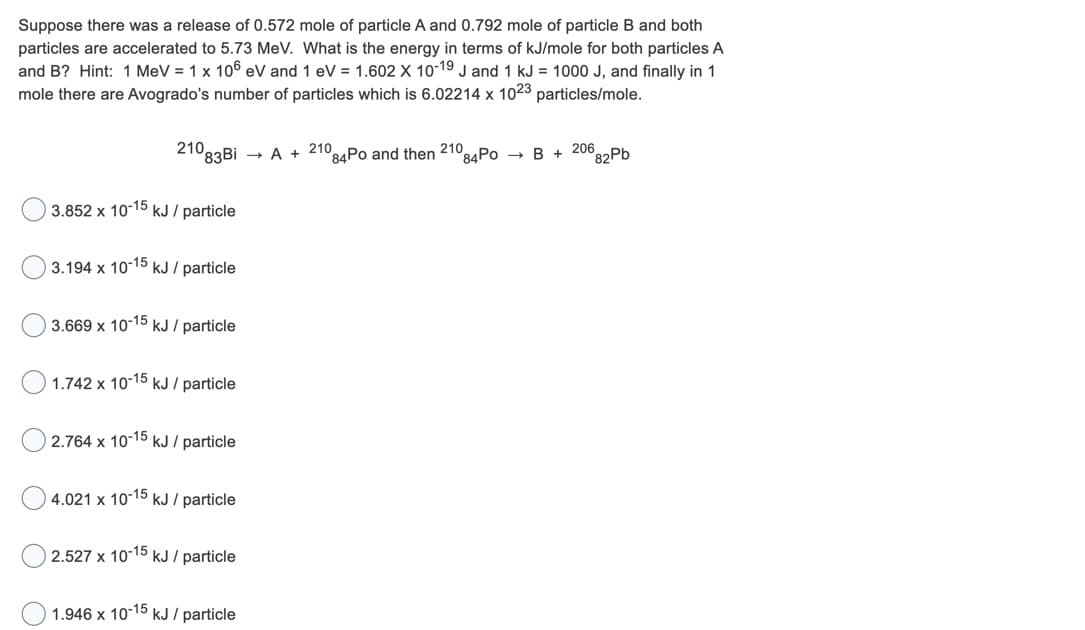Suppose there was a release of 0.572 mole of particle A and 0.792 mole of particle B and both particles are accelerated to 5.73 MeV. What is the energy in terms of kJ/mole for both particles A and B? Hint: 1 MeV = 1 x 106 eV and 1 eV = 1.602 X 10-19 J and 1 kJ = 1000 J, and finally in 1 mole there are Avogrado's number of particles which is 6.02214 x 1023 particles/mole. 210. Po and then 210. 206 Ph
Suppose there was a release of 0.572 mole of particle A and 0.792 mole of particle B and both particles are accelerated to 5.73 MeV. What is the energy in terms of kJ/mole for both particles A and B? Hint: 1 MeV = 1 x 106 eV and 1 eV = 1.602 X 10-19 J and 1 kJ = 1000 J, and finally in 1 mole there are Avogrado's number of particles which is 6.02214 x 1023 particles/mole. 210. Po and then 210. 206 Ph
Introductory Chemistry: An Active Learning Approach
6th Edition
ISBN:9781305079250
Author:Mark S. Cracolice, Ed Peters
Publisher:Mark S. Cracolice, Ed Peters
Chapter20: Nuclear Chemistry
Section: Chapter Questions
Problem 44E
Related questions
Question
There are more answers than shown in the photo.

Transcribed Image Text:Suppose there was a release of 0.572 mole of particle A and 0.792 mole of particle B and both
particles are accelerated to 5.73 MeV. What is the energy in terms of kJ/mole for both particles A
and B? Hint: 1 MeV = 1 x 106 eV and 1 eV = 1.602 X 10-19 J and 1 kJ = 1000 J, and finally in 1
mole there are Avogrado's number of particles which is 6.02214 x 1023 particles/mole.
21083Bİ → A + 210,
84Po and then 210.
84PO → B + 206
°82PB
3.852 x 10-15 kJ / particle
3.194 x 10-15 kJ / particle
3.669 x 10-15 kJ / particle
1.742 x 10-15 kJ / particle
2.764 x 10-15 kJ / particle
4.021 x 10-15 kJ / particle
2.527 x 10-15 kJ / particle
1.946 x 10-15 kJ / particle
Expert Solution
This question has been solved!
Explore an expertly crafted, step-by-step solution for a thorough understanding of key concepts.
Step by step
Solved in 3 steps

Knowledge Booster
Learn more about
Need a deep-dive on the concept behind this application? Look no further. Learn more about this topic, chemistry and related others by exploring similar questions and additional content below.Recommended textbooks for you

Introductory Chemistry: An Active Learning Approa…
Chemistry
ISBN:
9781305079250
Author:
Mark S. Cracolice, Ed Peters
Publisher:
Cengage Learning

Principles of Modern Chemistry
Chemistry
ISBN:
9781305079113
Author:
David W. Oxtoby, H. Pat Gillis, Laurie J. Butler
Publisher:
Cengage Learning

Chemistry: Principles and Reactions
Chemistry
ISBN:
9781305079373
Author:
William L. Masterton, Cecile N. Hurley
Publisher:
Cengage Learning

Introductory Chemistry: An Active Learning Approa…
Chemistry
ISBN:
9781305079250
Author:
Mark S. Cracolice, Ed Peters
Publisher:
Cengage Learning

Principles of Modern Chemistry
Chemistry
ISBN:
9781305079113
Author:
David W. Oxtoby, H. Pat Gillis, Laurie J. Butler
Publisher:
Cengage Learning

Chemistry: Principles and Reactions
Chemistry
ISBN:
9781305079373
Author:
William L. Masterton, Cecile N. Hurley
Publisher:
Cengage Learning

Principles of Instrumental Analysis
Chemistry
ISBN:
9781305577213
Author:
Douglas A. Skoog, F. James Holler, Stanley R. Crouch
Publisher:
Cengage Learning

Chemistry: Principles and Practice
Chemistry
ISBN:
9780534420123
Author:
Daniel L. Reger, Scott R. Goode, David W. Ball, Edward Mercer
Publisher:
Cengage Learning

Introduction to General, Organic and Biochemistry
Chemistry
ISBN:
9781285869759
Author:
Frederick A. Bettelheim, William H. Brown, Mary K. Campbell, Shawn O. Farrell, Omar Torres
Publisher:
Cengage Learning